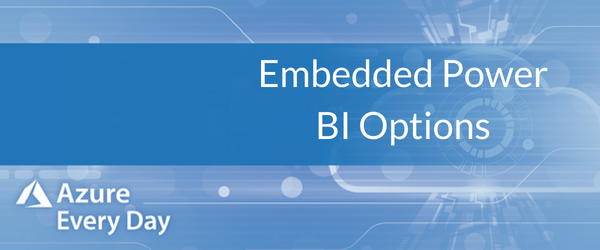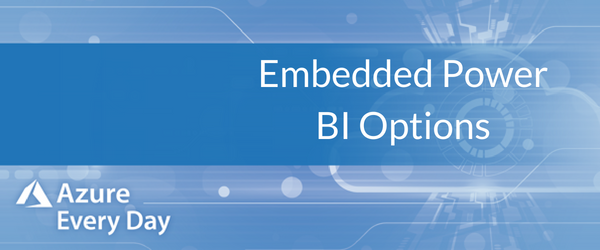Newsletter
Join our blog
Join other Azure, Power Platform and SQL Server pros by subscribing to our blog.


-1.png)
Start with the FREE community plan and get your lifetime access to 20+ courses. Get Instant Access Now!
Need help? Talk to an expert: (904) 638-5743

 By now, most are aware of Power BI and its capabilities to visualize their data. Many people like to bring Power BI to their users by putting Power BI in their applications and Microsoft’s offering of Power BI Embedded is a great option in this scenario. Today I’ll talk about a couple implementation options around Power BI Embedded.
By now, most are aware of Power BI and its capabilities to visualize their data. Many people like to bring Power BI to their users by putting Power BI in their applications and Microsoft’s offering of Power BI Embedded is a great option in this scenario. Today I’ll talk about a couple implementation options around Power BI Embedded.
First, let’s talk about Power BI Embedded in Azure. With this, you can purchase Power BI Embedded capacity right from Azure. This is meant for users outside of your organization and your domain. You can have users within your organization use it, but they must have a Power BI license, Pro or Premium, to use Power BI directly in Azure.
This is a great option when you want to use Power BI in a public facing application, without having the need to manage user accounts with Power BI. In this scenario, Microsoft considers the application to own the Power BI capacity. The users that join you by using the applications, would be using a master user or something similar to access it and get that capacity and ability to use Azure; they don’t have to have access to your domain to use it.
The more commonly known embedding is in Office. This premium version of Power BI is designed for internal use in your organization. In this scenario it gives you coverage for main users in your organization by using their free license options for interacting with the Power BI report and dashboards that you choose to deploy.
The Office capacity is owned by the users; it’s a user-named license scenario. If you’re using Power BI Premium, all the users in your domain typically have a user account and a free or Pro Power BI license they can use to access this and stay in compliance.
There is still a bit of a lack of clarity in some blended implementations. If you have an app or website that has both external and internal users, a customer support site for instance, it’s probably best to use Azure for the embedded scenario here. But do make sure all your users in your organization have license coverage.
This will allow you the best of both worlds but at the same time you’re blending. It’s probably best to work with Microsoft in this case as it’s still unclear of the right way to handle this.
Finally, it’s important to remember that if you have content creators in your organization, it doesn’t matter what Power BI solution you’re using, they need a Pro license to create and deploy content.
So, these are just a couple of options with embedding but be aware of the licensing around this. But I do think it’s cool that you can get capacity directly from Azure to support Power BI in your applications.
If you have any questions about Power BI Embedded in Azure or about any Azure topic, product or resource, we are the Azure experts. We love Azure and can help you with questions, planning or implementation of anything Azure, no matter where you are on your journey. Click the link below or contact us.
ABOUT THE AUTHOR
Free Community Plan
private training
Newsletter
Join other Azure, Power Platform and SQL Server pros by subscribing to our blog.


-1.png)
Leave a comment